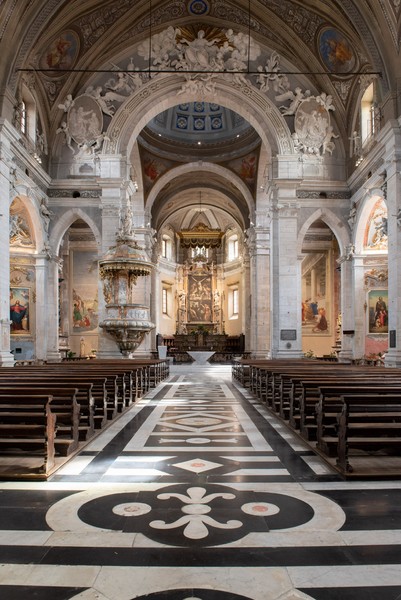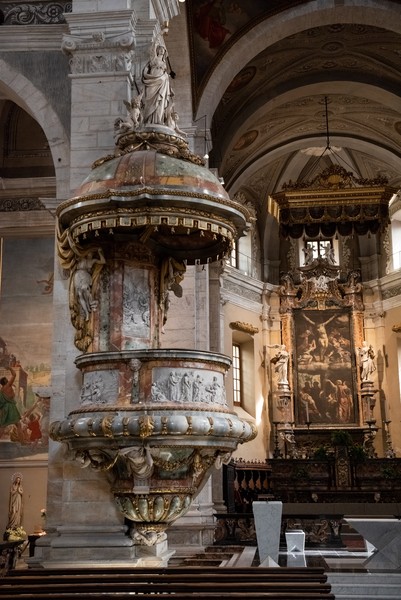COLLEGIATE OF SAINTS PETER AND STEPHEN
Collegiata dei Santi Pietro e Stefano
Piazza Collegiata
6500 Bellinzona
A first church dedicated to Saints Peter and Stephen was raised at Bellinzona in the early 1400s, however due to the risk of collapse, this building was demolished and starting in 1515, a new one designed by Tommaso Rodari (c. 1460-1526) was constructed. The plan featured a single nave with square choir at the east, and roofing with masonry vaults. The consecration of the high altar took place on 15 June 1565, although the façade was not completed until the following century (Fig. 1).
The current structure of the chancel area dates to the 18th century, when the building was provided with a shallow pseudo-transept and an expanded choir, in works directed by Giuseppe Caresana (documented from 1696 to 1764), and also as a second sacristy. Also from the 18th century are the stucco decorations of the windows and triumphal arch and the scagliola panels decorating the altar tables, the latter by Giuseppe Maria Pancaldi (c. 1700-1778) (Fig. 2).
In the 19th century, the entry steps were built and between 1849 and 1850, the interior pictorial decorations were renewed and the marble floor of the nave installed. At the end of the 20th century, two restoration campaigns remedied serious problems of maintenance and conservation. The first, between 1981 and 1985, mainly concerned the masonry and façade; the second, between 1990 and 1999, dealt with the interior.
Chapel of Corpus Christi
Sala Francesco
The Chapel of Corpus Christi (Fig. 3), seat of the confraternity of the same name, is third from the entrance on the right side, and is documented with its current dedication since 1547.
The stuccos were executed in 1596 by Giovanni Battista Lezeno (or Lezzeno, active 1596-1607) and Francesco Sala (active 1595 to c.1650)1 to a design by the painter Bartolomeo Gorla (d. 1624). Notably, these are among the oldest stucco works, apart from a few Romanesque examples, in all of Ticino (Fig. 4, 5, 6).
The eight canvases decorating the chapel, including the altarpiece with Last Supper, were painted between 1601 and 1607 by Camillo Procaccini (1561-1629) and workshop, while the neo-classical altar dates to 1778.
Chapels of Saint Anne and the Nativity
The arches that set out the nave are decorated with 16 stucco statues of Prophets, Sibyls, Evangelists and Fathers of the Church,(Fig. 7, 8, 9, 10) created by the various artists who worked in the chapels from time to time but striving for a unified overall effect, beginning from the earliest statues created by Lezeno and Sala. Among the stuccatori active was the famous Giovanni Battista Barberini (1625-1691/1692), whose presence is documented from 1661. The master was involved in the decoration of the chapels of St Anne (Fig. 11) and the Nativity (Fig. 12) (the first two on the left of the entrance). After his death, the works in the other chapels were probably completed by his collaborators.





































